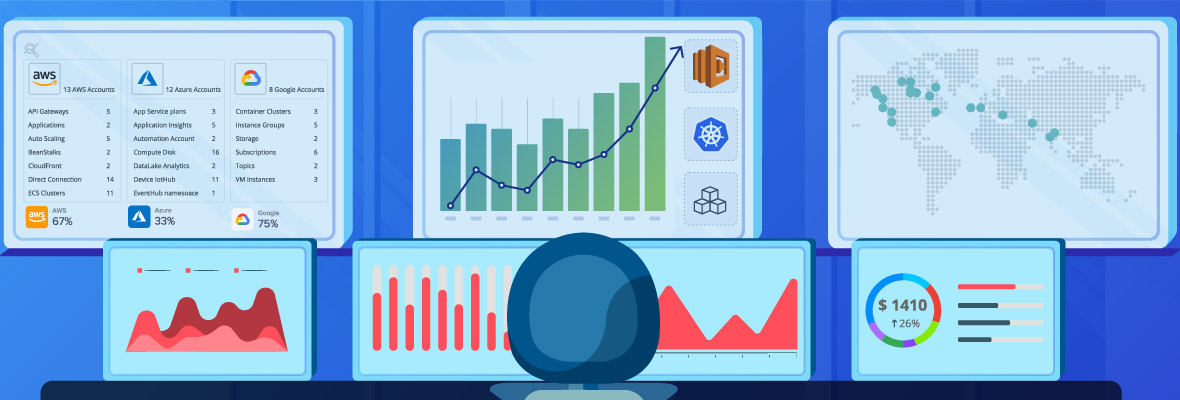As organizations embrace a combination of hybrid, multi-cloud, and cloud-native infrastructure to optimize business services, technology teams are struggling to control the chaos of their complex IT environments. IT operators need to piece together availability and performance data across different applications and infrastructure components to truly understand the true health of their enterprise services.
Deloitte’s Cloud Complexity Survey shows that nearly 50% of organizations found that the cloud was more complex than they had anticipated and 47% of CXOs felt that cloud complexity would have the biggest impact on delivering value from their cloud initiatives. In our recent Tech Talk, Command Center, Outdated, or Perfect Time for IT Operations? OpsRamp's Curt Thorin and Darren Cunningham spoke about the need for a digital operations command center in today’s hybrid and multi-cloud environment.
The Dark Side of a Multi-Cloud Environment
The world of IT operations has increasingly shifted to a hybrid and multi-cloud world. RightScale’s 2019 State of the Cloud Report found that 84% of organizations plan to adopt a multi-cloud strategy with only 10% of respondents betting on a single public cloud provider. The reasons behind this are varied: some IT teams like the flexibility of matching the workloads to the best provider while others are looking to avoid vendor lock-in and optimize pricing. Even so, discovering, monitoring, and optimizing a complex IT footprint brings a new set of operational challenges that involve:
- Tool Sprawl. The rise of cloud infrastructure and SaaS applications have been beneficial to modern enterprises in many ways. But this has also contributed to tool sprawl which involves the use of too many one-off specialized solutions. DEJ’s The Roadmap to Becoming a Top Performing Organization in Managing IT Operations report found that nearly 40% of IT teams are using 10+ monitoring tools, leading to blind spots while troubleshooting critical outages.
- Organizational Silos. A core tenet of building a DevOps culture is to break down functional silos for better organizational alignment. Silos happen when two teams work on practically identical initiatives, but neither of them is aware of what the other is doing. Growing infrastructure complexity can mean that teams within an organization are not able to coordinate well with each other, leading to duplicated efforts, wasted time, and dissatisfied customers.
- Missing Visibility. Despite having invested in multiple tools, organizations still suffer from a lack of visibility and transparency on their IT health. The State of Cloud Monitoring report found that 70% of organizations report that monitoring cloud environments is harder than monitoring data centers or private clouds, and nearly half experience performance issues from a lack of cloud visibility.
- Digital Downtime. Digital downtime has also skyrocketed. DEJ has found that the average estimated monthly revenue loss due to performance-related slowdowns is $2,129,000. IT outages are no longer about efficiency or productivity but about the impact on the organizational bottom-line.
Why You Need a Digital Operations Command Center for IT Operations
Enterprise IT teams are increasingly adopting a shared-services model to achieve centralized scalability, flexibility, and efficiency of their overall IT operations. The digital operations command center delivers a single source of truth across enterprise shared services for greater operational agility while maintaining governance and control. Here are three benefits of adopting a command center for IT operations management:
- Visibility and Control. IT operators can gain instant visibility by combining data from multiple sources and troubleshooting issues with confidence using hybrid visibility dashboards that help make the right decisions at the right time.
- Operational Readiness. A command center helps enterprise IT teams work at the speed of the business by standardizing IT operations functions, reallocating routine tasks, and retiring redundant point tools.
- Economies of Scale. A command center helps deliver operational productivity and cost savings across business units with shared services delivery. IT operations teams can also offer customized service tiers that allow each business unit to choose their level of service.
The need for a command center is more urgent than ever with remote IT operations. Having a central place to view and act upon monitoring data ensures reliable and resilient IT services with higher availability, quicker incident response, and better risk mitigation so that enterprise IT can support employee and customer priorities.
Check out the Tech Talk by accessing the webinar slides below or by watching the on-demand Tech Talk to learn more about OpsRamp’s Command Center.






